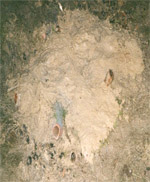| From the XIth to th XIVth century, the
techniques evolve/move but especially of new materials
produced by specialized craftsmen are employed: the
phenomenon is all the more significant since it goes hand
in hand with other comparable innovations in other
sectors, and in particular in the frame. Thus stone
construction, there or it is available, or out of brick,
near clay layers, appear and spread themselves with the
emergence of the feudal company. In addition, the product
obtained, the house, changed nature: it becomes a
permanent, transmissible masonry during some generations
and sheltering consequently a family. A new mentality, a
new form of relation between the human ones and their
house appear then. The brick is present in Europe
among Romans, but it does not re-enter in manners of the
High Age means, that which concern to us appears towards
1170, along the coasts of the North Sea in mobilities of
the religious commands Cisterciens and Prémontrés,
large builders of monasteries and churches. In Flanders,
the first traces of manufacture of bricks are due to the
cistercians of the abbey of the Dunes of Coxyde towards
1220. These monks essaimèrent, and in XIIIème century
those of Clairmarais have a tilery like perhaps those of
Bergues and Bourbourg. It thus seems that these religious
commands are the first to have manufactured bricks on an
industrial scale, which is explained especially for
reasons of a nature financial and practical, the chain
implemented not being profitable immediately, although
all the elements necessary were on the spot (clay, water,
sand, wood). The production of bricks required a complex
infrastructure making it possible to coordinate all the
stages of the production: winning and preparation of the
clay, moulding, drying and cooking of bricks out of
grinding stones, transport - supported in maritime plain
by a significant network of navigable water ways.
The cooking of bricks requires a temperature higher
than 900°C during several hours. The oldest technique
seems to be the grinding stone: made temporary structure
of bricks they-even, piled up in lines alternated with
fuel. With 4 to 10 m on side on 3 to 6 Mr. height, these
structures of at least 40.000 bricks, were covered with
clay to form a true room of cooking. This mode of cooking
will perdura until the beginning of the century in, then
the still many ones, brickyards of the area. At the time,
the brick of " Bernard saint " is different
from our since its basic module is of 29x14x9,5 cm. This
one progressively will be reduced and approached the
current module (approximately 20x10x7,5 cm), while taking
to a dominating place initially in the religious
architecture and soldier then civil (markets, belfries,
town halls) and urban with the typical Flemish frontages
with pinion in degrees (Arras, Furnes...). They replace
by là-même constructions with wood sides, just like it
thatch was replaced little by little for reasons of
security and solidity by the tile.
The littoral origin of the plain makes that local clay
is strongly sandy giving after cooking a brick or a
yellow tile of hue to orange typical of the Flemish
buildings of this microcomputer-area, and, although
massively replaced by red bricks during the rebuilding
which followed the Second World war, the yellow brick is
and remains a symbol identitaire extremely.
|




